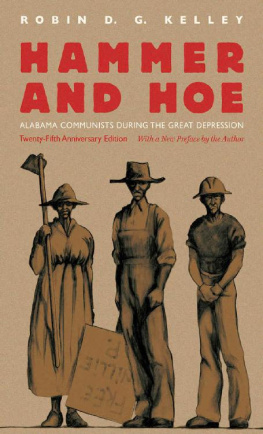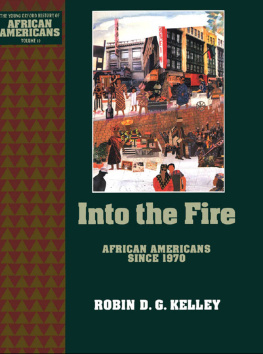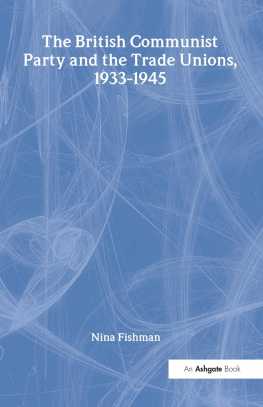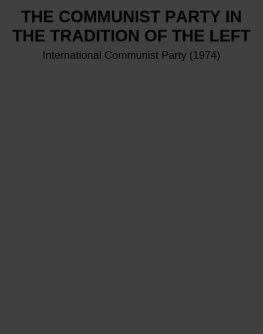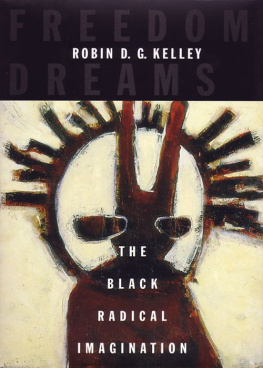Hammer and Hoe
Hammer and Hoe
Alabama Communists during the Great Depression
Robin D. G. Kelley
Twenty-Fifth Anniversary Edition
With a New Preface by the Author
The University of North Carolina Press
Chapel Hill and London
1990 The University of North Carolina Press
Preface to the Twenty-Fifth Anniversary Edition 2015 The University of North Carolina Press
All rights reserved
Manufactured in the United States of America
The paper in this book meets the guidelines for permanence and durability of the Committee on Production Guidelines for Book Longevity of the Council on Library Resources.
ISBN 978-1-4696-2548-5
ISBN 978-1-4696-2549-2
The Library of Congress has cataloged the original edition of this book as follows:
Kelley, Robin D. G.
Hammer and hoe: Alabama Communists during the Great Depression /
by Robin D. G. Kelley.
p. cm.(The Fred W. Morrison series in Southern studies)
Includes bibliographical references.
I. CommunismAlabamaHistory20th century. 2. Communists
AlabamaHistory20th century. 3. Depressions1929Alabama.
I. Title. II. Series.
HX9I.A2K45 1990
324.2761'075'09042dc20 90-50018
CIP
Dedicated to the young people of Ferguson, St. Louis, Baltimore, Miami, New York, Los Angeles, Chicago, Oakland, Gaza and the West Bank, Sao Paulo and Rio de Janeiro, Dakar, Cairo, Ayotzinapa and Mexico City, Santiago, Athens, Lisbon, Madrid, and elsewhere, fighting for justice, democracy, peace, and an end to human misery.
Contents
Illustrations
Black convict laborers, Banner Mine, Alabama
Al Murphy
Hosea Hudson
Sharecropping family, near Eutaw, Alabama
Lemon Johnson, SCU secretary of Hope Hull, Alabama, local
Company suburb
Clyde Johnson
Meat for the Buzzards!
Anti-Communist handbill distributed by the Ku Klux Klan
Fight Lynch Terror!
Smash the Barriers!
District 17 secretary Robert Fowler Hall
Sit-down strike, American Casting Company, Birmingham, 1937
Share Croppers Union membership card
Eugene Bull Connor, Birmingham city commissioner
League of Young Southerners
Ethel Lee Goodman
Segregated audience in Montgomery awaits Henry Wallace, 1948
Preface to the Twenty-Fifth Anniversary Edition
The Strange Career of Hammer and Hoe
How is this for timing: the postCold War and the publication of Hammer and Hoe are both twenty-five years old. Or to put it another way, I published an entire book about the trials, tribulations, and virtues of a Communist movement in the U.S. South just as Communismin its Soviet variety, at leasttook its last breath. The demise of the USSR should have no bearing on the historical value of Communism, but in the early 1990s, few conservative or liberal critics saw any reason to revisit Communist movements besides performing an autopsy. Given how obsessed with the present our culture is, once Communists ceased to be our greatest existential threat, they became, at best, relics of the past and, at worst, the twentieth centurys biggest losers.
Yet Id be lying if I said Hammer and Hoe was conceived as a purely academic contribution, unburdened by presentist concerns. The books genesis cannot be understood absent an understanding of the political and personal context in which it was written. I felt a fierce urgency to study black working-class radicalism, not because the old Soviet states were crumbling in the face of revolt, but because the apartheid state of South Africa was succumbing to a massive multiracial movementa movement in which Left trade unions and the South African Communist Party played leading roles. Far more than the fall of the Berlin Wall, Nelson Mandelas release from prison and Namibian independence, both in 1990, best represented the politics behind this book. Even the title was inspired by events in Africa. In 1970, the Peoples Republic of the Congo, a self-declared Marxist-Leninist socialist state, adopted the symbol of a crossed hammer and hoe for its flag. (Coincidentally, the regime and its flag were replaced in 1992another Cold War casualty.) I had entered UCLAs graduate program in 1983 as an Africanist. Modern South Africa was my chosen field, and the ways in which black workers struggled under regimes of racial capitalismhow they resisted exploitation, what they fought for, how they came to define political liberationwas my primary obsession. For my doctorate, I planned to write a social history of black radical politics in South Africa that would be attentive to the culture and ideas of ordinary people.
There was little indication that the 1980s would be the last decade of the Cold War. This was the era of Reaganism and Thatcherism, new imperialist wars, and new revolutions in Africa, Asia, and Latin America; of capital flight, the erosion of the welfare state, neoliberal privatization schemes, the weakening of antidiscrimination laws and policies; of a wave of police and vigilante killings that struck our communities with the force of a cluster bomb. The decade, in fact, opened with police killings and nonlethal acts of police brutality emerging as a central political issue, resulting in a massive urban insurrection in Liberty City, Florida, in May 1980. The 1980s also witnessed genuine efforts by radicals to build multiracial solidarity in the unlikely realm of electoral politics. The election of Mayor Harold Washington in Chicago in 1983, along with Jesse Jacksons 1984 presidential bid, held the radical promise of Rainbow Coalition politics.
At the same time, like many of my fellow students in the early to mid-1980s, I was involved in the anti-apartheid movement. By the time I set foot on UCLAs campus in the fall of 1983, the boycott and divestment movement against South Africa was in full swing. I was active in a sectarian party pursuing dreams of socialist revolution, elected president of UCLAs African Activists Association, and chaired the Ad Hoc Committee to Keep South Africa Out of the Olympics, which were held in Los Angeles in the summer of 1984. We were part of a broad coalition of students calling on the University of California to divest its holdings from South Africa. We built makeshift shantytowns on campus, sat in at the South African Consulate, educated our community, built momentum, and by the summer of 1986 persuaded the U.C. Regents to divest their $3.1 billion worth of holdings from South Africa and Namibia. While we won that battle, none of my comrades believed divestment alone would topple apartheid and birth a new democratic state founded on the principles of the Freedom Charter. We knew that the struggle inside of South Africa mattered most. And given the experiences of Mozambique, Guinea-Bissau, Angola, and Namibia, we knew it would be bloody. The United Democratic Front, the African National Congress, and the Congress of South African Trade Unions (COSATU) demonstrated the power of massive popular resistance, strikes, civil disobediencethe power of people to stop South Africas racial regime from functioning.
Though it may seem hard to believe now, these were revolutionary times, politically and theoretically. In the fog of negotiating movement work and school work, I embraced a group of radical thinkers who believed another world was possible. C. L. R. James, W. E. B. Du Bois, Walter Rodney, Amlcar Cabral, Manning Marable, Audre Lorde, June Jordan, Ngg wa Thiongo, Angela Davis, Chinweizu, Vincent Harding, Cornel West, Barbara Smith, Stuart Hall, Edward Said, and Samir Amin, among others, wrote about the ravages of racial capitalism, the violence of patriarchy, the futility of parochial politics in the face of global imperialism, and the absolute necessity to resist. It was never about a failing in the Lefts ability to mobilize black people but our conceptual failure to recognize a black radical tradition critical of, and illegible to, a Euro-American Left formed by the logic of Western civilization. When this tradition found its way into Left movementsin Africa, Latin America, even the United Statesit brought its own unique vision, historical sensibility, and set of resistance strategies to the Communist movement; in doing so, it altered the Party. In other words, whereas most scholars set out to prove just how alien Communism was to black people, Robinson compelled me to ask what black peoplein this case, black South Africansbrought to the Left to make it their own. The presumed objects of Communist machinations became subjects and agents in making their own history.
Next page
